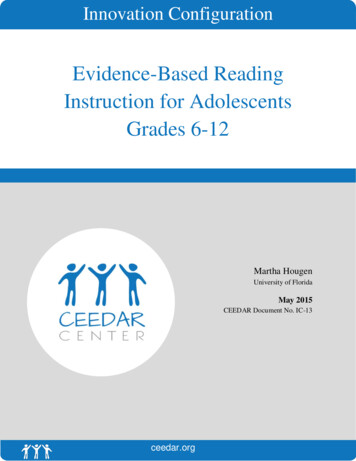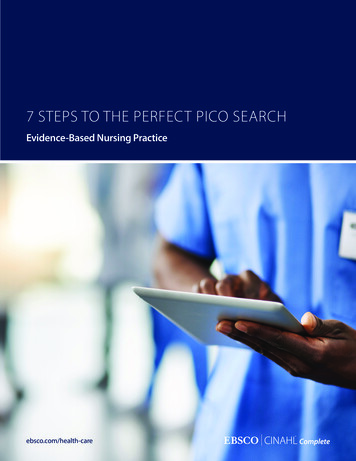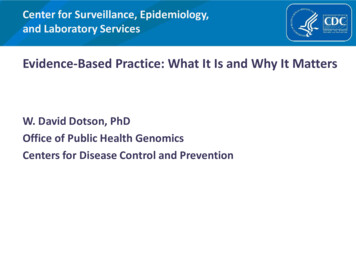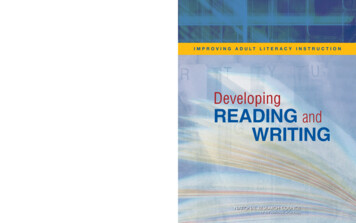
Transcription
Innovation ConfigurationEvidence-Based ReadingInstruction for AdolescentsGrades 6-12Martha HougenUniversity of FloridaMay 2015CEEDAR Document No. IC-13ceedar.org
Disclaimer:This content was produced under U.S. Department of Education, Office of SpecialEducation Programs, Award No. H325A120003. Bonnie Jones and David Guardino serveas the project officers. The views expressed herein do not necessarily represent thepositions or polices of the U.S. Department of Education. No official endorsement by theU.S. Department of Education of any product, commodity, service, or enterprisementioned in this website is intended or should be inferred.Recommended Citation:Hougen, M. (2014). Evidence-based reading instruction for adolescents, grades 6-12(Document No. IC-13). Retrieved from University of Florida, Collaboration forEffective Educator, Development, Accountability, and Reform Center vation-configurations/Note: There are no copyright restrictions on this document; however, please use the propercitation.Page 2 of 93
Table of ContentsList of Figures . 6Innovation Configuration for Evidence-Based Reading Instruction for AdolescentsGrades 6-12 . 7Teacher Education . 9Organization of the Innovation Configuration . 11Increasing Intensity of Instruction in Tiers 2 and 3 . 13Definition of Terms . 14Adolescent Literacy . 14Academic Literacy and Disciplinary Literacy . 14Limitations of the Innovation Configuration . 15Evidence-Based Reading Instruction: Knowledge of the EssentialComponents . 16Essential Component 1: Word Recognition and Word Study . 17Word Recognition . 17Word Study. 18Tier 1: General Education Core Classroom Instruction for All Students . 18Tiers 2 and 3: Intervention Instruction for Word Recognition andWord Study. 20Essential Component 2: Fluency. 22Evidence-Based Reading Instruction: Fluency . 24Tier 1: General Education Core Classroom Instruction for All Students . 24Tiers 2 and 3: Intervention Instruction . 25Page 3 of 93
Essential Component 3: Vocabulary. 26Role of Vocabulary in Comprehension . 26Tier 1: General Education Classroom. 27Additive, Generative, and Academic Vocabulary Instruction . 28Selection of Vocabulary Words to Teach . 29Developing Word Consciousness . 30Evidence-Based Reading Instruction: Vocabulary . 31Tier 1: General Education Core Classroom Instruction for All Students . 31Tiers 2 and 3: Intervention Instruction . 35Essential Component 5: Text Comprehension . 36Tier 1: General Education Core Classroom Instruction for All Students . 37Tiers 2 and 3: Intervention Instruction . 45Differentiating Instruction, Instructional and Assistive Technology, Digital and Web-BasedInstruction, and Universal Design for Learning. 46Differentiating Instruction . 46Instructional and Assistive Technology . 47Digital and Web-Based Instruction. 48Universal Design for Learning . 49Disciplinary Literacy . 51Disciplinary Literacy: English/Language Arts. 52Disciplinary Literacy: Social Studies/History . 53Disciplinary Literacy: Science . 55Disciplinary Literacy: Mathematics. 55Page 4 of 93
Tiers 2 and 3: Reading Comprehension Intervention Instruction . 56Conclusion . 58References . 59Appendix: Innovation Configuration for Evidence-Based Reading Instructionfor Adolescents, Grades 6-12 . 94Page 5 of 93
List of FiguresFigure 1: Verbal & Visual Word Association Strategy . 34Figure 2: A Word Map . 35Page 6 of 93
Innovation Configuration for Evidence-Based Reading Instruction for AdolescentsGrades 6-12This paper features an innovation configuration (IC) matrix that can guide teacher preparationprofessionals in the development of appropriate use of evidence-based reading instruction foradolescents in Grades 6-12. This matrix appears in the Appendix.An IC is a tool that identifies and describes the major components of a practice or innovation.With the implementation of any innovation comes a continuum of configurations ofimplementation from non-use to the ideal. ICs are organized around two dimensions: essentialcomponents and degree of implementation (Hall & Hord, 1987; Roy & Hord, 2004). Essentialcomponents of the IC—along with descriptors and examples to guide application of the criteriato course work, standards, and classroom practices—are listed in the rows of the far left columnof the matrix. Several levels of implementation are defined in the top row of the matrix. Forexample, no mention of the essential component is the lowest level of implementation and wouldreceive a score of zero. Increasing levels of implementation receive progressively higher scores.ICs have been used in the development and implementation of educational innovations for atleast 30 years (Hall & Hord, 2001; Hall, Loucks, Rutherford, & Newton, 1975; Hord,Rutherford, Huling-Austin, & Hall, 1987; Roy & Hord, 2004). Experts studying educationalchange in a national research center originally developed these tools, which are used forprofessional development (PD) in the Concerns-Based Adoption Model (CBAM). The toolshave also been used for program evaluation (Hall & Hord, 2001; Roy & Hord, 2004).Use of this tool to evaluate course syllabi can help teacher preparation leaders ensure that theyemphasize proactive, preventative approaches instead of exclusive reliance on behaviorreduction strategies. The IC included in the Appendix of this paper is designed for teacherpreparation programs, although it can be modified as an observation tool for PD purposes.The Collaboration for Effective Educator, Development, Accountability, and Reform(CEEDAR) Center ICs are extensions of the seven ICs originally created by the NationalComprehensive Center for Teacher Quality (NCCTQ). NCCTQ professionals wrote the abovedescription.Page 7 of 93
Results of recent national and international assessments indicate a combination of goodand bad news about adolescent literacy. First, the National Assessment of Educational Progress(NAEP; 2013) reading results on the May 2014 report indicate that the average reading scoresfor fourth- and eighth-graders are higher than on previous test administrations. However, only36% of eighth-graders and 35% of fourth-graders scored at proficient reading levels. Second,both Black and Hispanic eighth-graders had higher average reading scores than on any previousassessment; however, the achievement gaps between Black and Hispanic students and those ofWhite students remain large (NAEP, 2013). Third, high school graduation rates have increasedfrom 74% to 81% for students in freshman classes. However, high school seniors’ performanceon the national assessment for reading remained the same when comparing the 2013 results withthose from 2009 and have decreased since the test was first administered in 1992. See completeresults at http://nationsreportcard.gov/reading math 2013/.The favorable NAEP (2013) news about students with disabilities is that this populationis included in the testing, with accommodations as needed. However, the discouraging news isthat about 69% of fourth-graders and 60% of eighth-graders with disabilities scored below basiclevels in reading on the 2013 NAEP (see http://nationsreportcard.gov/reading math 2013/ /student-groups). An analysis of the 2011 vocabulary assessment revealed that, on average,students with disabilities at all three grades (i.e., fourth grade, eighth grade, and 12th grade)scored lower than students without disabilities (U.S. Department of Education, 2014a).Overall, the reading scores of secondary students have not significantly improved andhave not kept pace with the increasing demands for literacy in the workplace (NAEP, 2011;RAND, 2002; U.S. Department of Education, 2012). Numerous reports published within thepast few years have attested to the fact that high school graduates are not prepared for the rigorsPage 8 of 93
of college or the demands of the workplace (Adams, 2011; Hanushek, Peterson, & Woessman,2014; Kamil et al., 2008; U.S. Department of Education, 2014b).There are an estimated six to eight million adolescents who struggle with reading insecondary schools (Biancarosa & Snow, 2004; Joftus & Maddox-Dolan, 2003; Vaughn, Denton,& Fletcher, 2010). Some struggling students may have reading disabilities; however, some ofthese students are not identified until they are in the upper elementary grades or even secondaryschool when it is difficult to provide the necessary interventions to close the achievement gap(Hock et al., 2009; Leach, Scarborough, & Rescorla, 2003; Vaughn & Fletcher, 2012).Secondary students with reading difficulties commonly have difficulties with decodingand fluency, which results in poor reading comprehension. Surprisingly, isolated readingcomprehension difficulties do not comprise the bulk of struggling readers (Catts, Adlof, &Weismer, 2006; Leach et al., 2003). Rather, difficulty mastering the basic skills of readingcontribute to the low levels of comprehension, and adolescent students with reading disabilitiestypically require interventions that address word-level decoding and fluency development as wellas comprehension (Scammacca, Roberts, Vaughn, & Stuebing, 2013; Vaughn et al., 2010). Forthese reasons, this IC focuses on developing adolescent readers’ abilities to decode multisyllabicwords, read with prosody, develop vocabulary knowledge, and increase reading comprehension.For secondary students who continue to have difficulties with the foundational skills of reading(i.e., phonemic awareness, basic phonics, and fluency), refer to Evidence-Based ReadingInstruction, Grades K-5 (Lane, 2014).Teacher EducationThe needs of struggling secondary students vary and present unique challenges, requiringteachers to plan instruction according to the needs of each student (Fagella-Luby, Schumaker, &Page 9 of 93
Deshler, 2008). In addition to students’ academic needs, teachers must also address theemotional and motivational needs of these adolescents. Adolescent struggling readersexperience a history of failure and frustration and often develop feelings of hopelessness andlack of trust in their abilities to academically succeed. They develop maladaptive habits such asreliance on guessing, fake reading, or just avoiding reading altogether. They realize theirknowledge deficits and the challenges awaiting them in the larger world (Moats, 2014; Novosel,2014; RAND, 2002).Students with reading difficulties present other challenges for their teachers. Secondaryteachers must not only support student reading achievement, but also must ensure that studentsgain relevant content knowledge despite their reading difficulties, and secondary teachers reportthat they are rarely prepared to teach students who struggle with reading, particularly in thecontent areas (Kamil et al., 2008; Ness, 2009; Snow, 2002). When teachers do learn strategies toteach struggling readers, they rarely receive ongoing support, and the strategies often are notimplemented with fidelity (James-Burdumy et al., 2009).Many elementary teachers are also inadequately prepared to teach young students forwhom learning to read and write is difficult (Bos, Mather, Dickson, Podhajski, & Chard, 2001;Joshi, Binks, Hougen, Dahlgren, et al., 2009; Joshi, Binks, Hougen, Dean et al., 2009; Moats,1994; Podhajski, Mather, Nathan, & Sammons 2009), yet they may not realize what they do notknow and think they are doing what is best for their students (Cunningham, Perry, Stanovich, &Stanovich, 2004; Spear-Swerling, Brucker, & Alfano, 2003, 2005). However, without theappropriate knowledge and skills, teachers are not able to meet the needs of struggling youngreaders; consequently, too many elementary students enter secondary schools significantlybehind their more able peers. As students age, it becomes increasingly difficult for them to catchPage 10 of 93
up and become ready for college and their careers. The good news is that when teachers receiveappropriate training and support over time, they learn and apply the essential components ofreading instruction, and their students make better progress (McCutchen et al., 2002; Moats &Foorman, 2003; Piasta, Connor, Fishman, & Morison, 2009; Spear-Swerling & Brucker, 2003).One reason teachers are not better prepared could be because the instructors who prepare teachercandidates do not have sufficient knowledge about how to teach students who struggle withreading and writing (Binks-Cantrell, Washburn, Joshi, & Hougen, 2012; Cheesman, Hougen,Smartt, 2010; Joshi, Binks, Hougen, Dahlgren, et al., 2009). This IC was designed to provideinstructors with knowledge about the most essential components of reading instruction tointegrate into their preparation programs. The accompanying IC matrix (see Appendix) andother materials provide additional resources to guide educators in providing candidates with theessential knowledge and skills secondary teachers require to be effective teachers of diversepopulations of students.Organization of the Innovation ConfigurationSection 1 of this IC—Evidence-Based Reading Instruction: Knowledge of the EssentialComponents—presents the knowledge base required by teachers for each essential component.Section 2—Evidence-Based Reading Instruction: Application of the Essential Components—focuses on what teachers must be able to do to effectively apply their knowledge with studentswith reading disabilities.Both sections are organized by essential components of reading instruction and tiers,corresponding to a Multi-Tiered System of Supports (MTSS) framework. Tier 1 comprises theknowledge and skills all teachers need in order to address adolescent literacy in core, generaleducation classrooms. Most students with reading difficulties continue to participate in generalPage 11 of 93
education classrooms and are expected to have access and opportunities to learn the curriculum.School wide, all teachers must know how to apply the most efficacious strategies to supportreading achievement, particularly vocabulary and comprehension instruction, across all contentareas (Vaughn & Fletcher, 2012). This is somewhat different from Tier 1 at the elementary levelbecause at the secondary level, it is more about differentiating and intensifying instruction so thatall students can be successful while at the elementary level, the focus is on ameliorating learningdifficulties by providing immediate interventions. Although it is true that some students areidentified as having disabilities in secondary schools (Wanzek et. al, 2013), the vast majority ofstudents have been identified as having disabilities before they enter the upper grades, and theability to prevent disabilities is no longer realistic (Vaughn & Fletcher, 2012).Tier 2 consists of more intensive instruction to students who have not mastered thematerial presented in Tier 1. Students are typically two or more grades below grade-levelreading expectations. In elementary schools, Tier 2 instruction is generally provided by generaleducation teachers to small groups of students, although some schools have specialists whoprovide more intensive instruction through a pull-out program or in small groups within generaleducation classrooms. However, in secondary schools, it appears to be more effective to provideongoing remediation classes, typically scheduled as elective classes and taught by qualifiedteachers (Vaughn & Fletcher, 2012).Tier 3 instruction focuses on students who struggle most with learning to read. Typically,students requiring intensive intervention are instructed for a minimum of 50 min per day in smallgroups by specialists and in settings other than general education classrooms. To date, there isno definitive research conclusions that define the most efficacious group size in which to teachPage 12 of 93
adolescent struggling readers, unlike conclusions recommending small group interventions forelementary students (Vaughn & Fletcher, 2012).Often, students identified with disabilities receive Tier 3 instruction in classes that may ormay not also include other struggling students. Some districts use a four-tiered (or more) model,with more intensive instruction occurring in subsequent tiers; typically, these tiers include onlystudents designated as having disabilities. The teachers who work with the students whostruggle the most must have in-depth knowledge about how to effectively teach these students.Recent research indicates that struggling readers, including those identified as have readingdisabilities as well as struggling readers not identified with a disability, benefit from intervention(A. Graves, Brandon, Duesbery, McIntosh, & Pyle, 2011; Lovett, Lacerenza, de Palma, &Frijters, 2012; Scammacca et al., 2013; Solis, Miciak, Vaughn, & Fletcher, 2014).Another difference in implementation in secondary schools is that students do not need tosequentially move through the tiers. When it is already evident that the students have notresponded to instruction based on their performance on valid assessments, it is urgent to providethem with more intensive instruction as soon as possible so that no time is wasted addressingtheir specific needs.Increasing Intensity of Instruction in Tiers 2 and 3There are three ways to intensify instruction: (a) work with smaller groups to allow formore opportunities for students to respond and receive feedback; (b) provide more explicit andsystematic instruction in order to break down skills into discrete elements; and (c) schedule moretime for intensive instruction, including more doses (i.e., more frequent sessions) over a greaterperiod of time (i.e., months or years).Extensive intervention instruction (i.e., Tier 3) that focuses on word-level skills,Page 13 of 93
vocabulary, fluency, and comprehension seems to have a small but positive impact on studentlearning (Edmonds et al., 2009; Scammacca et al., 2007; Wanzek et al., 2013). However, recentresearch has demonstrated that secondary students with significant reading difficulties, such asstudents identified with learning disabilities in reading, need intense and sustained interventionsto maintain reading growth each year (Wanzek et al., 2013). Accelerating their growth, which isnecessary for students to meet grade-level standards, is especially challenging and requireswell-prepared, knowledgeable, highly effective teachers.Definition of TermsAdolescent LiteracyAdolescent literacy refers to reading instruction for students in Grades 6-12; thus, thefoundational skills most students acquire in elementary grades (i.e., phonological skills,phonemic awareness, and listening comprehension) are not emphasized. The essential elementsfor early reading instruction for Grades K-5 are reviewed in a companion IC (Lane, 2014).It is important to note that students learn at different rates and bring various skill levels toclassrooms, and teachers will encounter secondary students who would benefit from instructionin foundational reading skills. Therefore, it benefits secondary teachers, leaders, and teachereducators to be knowledgeable about early reading instruction so that they can recognize andaddress the foundational gaps some adolescents may exhibit.In addition to the basic skills required to read, academic literacy and disciplinary literacyare two concepts that have received considerable attention recently.Academic Literacy and Disciplinary LiteracyTo ensure that all students are prepared for college and their careers, the expectations ofstudents have increased, and the Common Core State Standards (CCSS) and other standards thatPage 14 of 93
emphasize college and career readiness require students to develop academic literacy. Academicliteracy refers to the skills required to read, comprehend, and learn from scholarly text in thevarious disciplines andencompasses the kind of reading proficiencies typically assessed on state-levelaccountability measures, such as the ability to make inferences from text, to learn newvocabulary from context, to link ideas across texts, and to identify and summarizethe most important ideas within a text. (Kosanovich, Reed, & Miller, 2010, p. 8)Disciplinary literacy refers to the specifics of reading, writing, and communicating in adiscipline. It focuses on the ways of thinking, the skills, and the tools experts in the disciplinesuse (Shanahan & Shanahan, 2012).Limitations of the Innovation ConfigurationReading is a complex activity, and successful reading includes multiple interrelatedprocesses. Because of space limitations, this IC addresses many, but not all, essentialcomponents of an efficacious secondary reading program. For example, there is not space todiscuss how to motivate adolescents to actively engage in literacy skills or how to create apositive social-emotional climate, both of which are essential considerations for secondaryschools (Guthrie, Anderson, Alao, & Rinehart, 1999; Guthrie & David, 2003; Kamil et al., 2008;Novosel, 2013; Kent, Wanzek, Swanson, & Vaughn, 2015). However, attention is given to howto support students in acquiring the requisite skills that enable them to be successful readers andbecome more motivated to read and further develop their skills.This IC also does not address the essential skill of writing to develop literacy. Writingcomplements reading, and both reading and writing skills must be taught simultaneously. SeeEvidence-Based Practices for Writing Instruction (Troia, 2014).Page 15 of 93
Finally, this IC does not address specific knowledge and skills to teach adolescentEnglish language learners; however, the principles and strategies discussed will support studentslearning English, although more principles and strategies may be necessary.It is also important to note that much of the cited research has limitations related to thegeneralizability of the conclusions, usually based on the low number of studies, particularly inGrades 9-12; the low number of subjects; and the lack of specificity about the subjects (e.g.,socioeconomic status [SES], race, first language; Reed, Sorrells, Cole, & Takakawa, 2013).References and additional resources are provided for those who want more information regardingthe essential components of adolescent literacy.Evidence-Based Reading Instruction: Knowledge of the Essential ComponentsDuring the past three decades, a convergence of evidence has isolated the skills thattypify good readers (Adams, 1990; Chall, 1967; Chall, 1983; National Reading Panel [NRP],2000). These skills include those that are typically mastered by young children, includingknowledge of the structure of language, listening skills, phonological awareness (especiallyphonemic awareness), and the alphabetic principle. Good readers learn to decode words byanalyzing every letter, mapping the letter to its sound, and blending the sounds together to read aword. For typical readers with efficient working memory, the ability to decode words becomesautomatic with practice, freeing cognitive space to concentrate on meaning (Adams, 1990; Ehri,2005, 2014). People who learn to easily read typically continue to read and become even betterreaders (Stanovich, 1986). They learn massive amounts of vocabulary through reading, gainknowledge about their world, and begin to read with fluency and prosody. Good readersrecognize the meaning in what they read and hone their comprehension skills to include theability to summarize, make inferences, compare and contrast passages, question what they read,Page 16 of 93
and relate new learning to current knowledge. They monitor their understandings and utilizeappropriate problem-solving skills to improve comprehension. Good readers can coordinatethese complex skills and apply effective strategies before, during, and after reading.Consequently, good readers experience the wonder, joy, and utility of reading. However, if onedoes not learn these skills, reading can be difficult and laborious, affecting academic success inall subjects and often leading to a life of struggle and frustration. Therefore, teachers must knowhow to scaffold the development of each requisite reading skill so that students learn toefficiently and effectively apply the skills. All of these skills are like separate strands of a ropethat, when woven tightly together, result in skilled reading (Scarborough, 2001).Essential Component 1: Word Recognition and Word StudyWord RecognitionThe ability to effectively and efficiently decode words is necessary for readingcomprehension (Boardman et al., 2008; Nagy, Berninger, & Abbott, 2006; Scammacca et al.,2007; Wharton-McDonald & Swiger; 2009). Researchers have determined that about one-thirdof middle school struggling readers have difficulty at the basic word level, and they havedifficulty with comprehension (Brasseur-Hock, Hock, Kieffer, Biancarosa, & Deshler 2011;Paulesu et al., 2001; Scammacca et al., 2013; Vaughn et al., 2010). Struggling adolescentreaders may be able to read single-syllable words but must be taught strategies to decodemultisyllabic words common in complex texts (Archer, Gleason, & Vachon, 2003). To do thiswell, students must be taught explicit strategies to decode unknown words (Biancarosa & Snow,2004; Pearson & Gallagher, 1983). Teachers who use explicit instruction explain the strategy,model the process, provide guided practice with scaffolding, and, finally, require independentapplication of the strategy.Page 17 of 93
There are three strategies students can learn to apply while reading unfamiliar words—decoding, analogizing, and predicting (Ehri, 2014). Students use a decoding strategy bytransforming the graphemes (i.e., letters) into a blend of phonemes to pronounce the word. If theword is familiar, students can decode it and then check to see if the word makes sense in context.The second strategy, analogizing, is useful to readers who have a large number of words storedin memory. They
as comprehension (Scammacca, Roberts, Vaughn, & Stuebing, 2013; Vaughn et al., 2010). For these reasons, this IC focuses on developing adolescent readers’ abilities to decode multisyllabic words, read with prosody, develop vocabulary knowle











